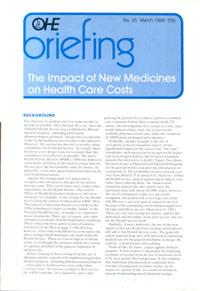Unlocking the Value of Combination Therapies

The objective of medical care is to make people as healthy as possible. Over the past 40 years, since the National Health Service was established in Britain, medical progress – including particularly pharmacological advances – has greatly extended the scope for the health…
The objective of medical care is to make people as healthy as possible. Over the past 40 years, since the National Health Service was established in Britain, medical progress – including particularly pharmacological advances – has greatly extended the scope for the health services to achieve this objective. However, this success has also led to steadily rising expenditure on the Health Service. As a result, there has been a very proper concern to ensure that this expenditure is as effective as possible. The latest Health Service Review (HMSO. 1989) has helped to concentrate attention on the need to ensure that the Service gives the best possible value for money. In particular, it has once again focused attention on the cost of pharmaceuticals.
Against this background, it is important to recognise that advances in therapy do not always increase costs. They can in some cases reduce other expenditure on the Health Service. The earliest Office of Health Economics booklet in 1962 drew attention, for example, to the savings for the Health Service from the control of tuberculosis (OHE 1962). The control of infectious diseases as a whole in the 1950s contributed a major economic ‘bonus’ to the National Health Service, to enable it to expand its newer treatments. There are, of course, also other substantial economic benefits from better treatment. These reduce the more general costs of sickness referred to in the Box on page 2. This Briefing, however, refers only to health service costs and to the direct savings which medicines can yield within the Health Service. These are real savings in economic terms, even though the resources which they release are quickly absorbed in the general expansion of medical care.
Impact of New Medicines on Health Care Costs
Teeling Smith, G.
(1989) Impact of New Medicines on Health Care Costs. OHE Briefing. Available from https://www.ohe.org/publications/impact-new-medicines-health-care-costs/